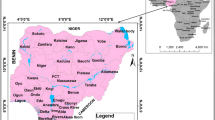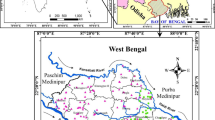Abstract
The aim of this study was to provide the overall assessment and identification of vulnerable area using the quantitative, qualitative and socio-economic assessment of groundwater resources in Kishangarh Tehsil of Ajmer district, Rajasthan, India. In quantitative assessment, the runoff and net recharge was estimated using the Soil Conservation Service Curve Number (SCN-CN) and water balance methods, respectively. While qualitative assessment was performed by conducting groundwater sampling and analyzing the different hydrochemical parameters. Finally, socio-economic assessment (SEA) was done by gathering information through questionnaire survey focused on groundwater issues with the native people. All three assessments were integrated to evaluate groundwater resource vulnerability. The water balance of area shows very low recharge rate, even during the monsoon season. The soil in the area has only a 0.04% total annual net recharge coefficient and extremely high concentrations of copper, and fluoride, as well as high salinity, and hardness. The hydro-geochemical condition of the drinking water was extremely worse. PCA analysis indicates that an increase in first principal component was associated with the increase in copper and chromium, while the increase in second component was linked to the increase in fluoride, iron and cadmium. Sampling locations tends to be clustered into three quadrants of the Cartesian plane. This suggests an increase in contamination when moving along the bisecting line away from the origin of the Cartesian plane. The groundwater from the location of the first group (Ankauriya, Sinodiya, Nosal, and Jajota) tends to be highly polluted because of the parameters of both first and second components. Furthermore, socio-economic assessment also reported that the groundwater resources showed high vulnerability. This study may help in planning groundwater management strategies and technological approaches for the sustainable natural resources development.









Similar content being viewed by others
References
Abildtrup J, Audsley E, Fekete-Farkas M, Giupponi C, Gylling M, Rosato P, Rounsevell M (2006) Socio-economic scenario development for the assessment of climate change impacts on agricultural land use: a pairwise comparison approach. Environ Sci Policy 9(2):101–115
Allen RG, Smith M, Pereira LS, Perrier A (1994) An update for the calculation of reference evapotranspiration. Int Comm Irrigation Drainage (ICID) Bull 43(2):1–34
Allen RG, Pereiro LS, Raes D, Smith M (1998) Crop evapotranspirtion: guidelines for computing crop requirements. Irrigation and Drainage Paper No. 56. FAO, Rome
Allen RG, Pereira LS, Smith M, Raes D, Wright JL (2005) FAO-56 dual crop coefficient method for estimating evaporation from soil and application extensions. J Irrigation Drain Eng 131(1):2–13
Balali H, Khalilian S, Viaggi D, Bartolini F, Ahmadian M (2011) Groundwater balance and conservation under different water pricing and agricultural policy scenarios: a case study of the Hamadan-Bahar plain. Ecol Econ 70(5):863–872. https://doi.org/10.1016/j.ecolecon.2010.12.005
Bhat AH, Sharma KC (2015) Physico-chemical analysis of groundwater quality of adjoining areas of Sambhar Lake, a Ramsar Wetland of Rajasthan, India. Curr World Environ 10(3):1039–1043
Boisson A, Baïsset M, Alazard M, Perrin J, Villesseche D, Dewandel B, Maréchal JC (2014) Comparison of surface and groundwater balance approaches in the evaluation of managed aquifer recharge structures: Case of a percolation tank in a crystalline aquifer in India. J Hydrol 519(2014):1620–1633
Central Ground Water Board, Ministry of Water Resources, Government of India (2008) “Groundwater scenario Ajmer District Rajasthan”, District Groundwater Brochure. Western Region Jaipur, June 2008
Central Ground Water Board, Ministry of Water Resources, Government of India (2011) Groundwater year book 2010–11, December 2011
Central Groundwater Board (2015) Groundwater year book 2014–2015 Rajasthan state. http://cgwb.gov.in/Regions/GW-year-Books/GWYB-2014-15/GWYB%2014-15%20Rajasthan.pdf. Accessed 5 Feb 2018
Chandra S, Saksena RS (1975) Water balance study for estimation of groundwater resources. J Irrigation Power 1975:443–449
Chandra S, Sharma D, Dubey SK (2018) Linkage of urban expansion and land surface temperature using geospatial techniques for Jaipur City, India. Arab J Geosci 11(2):31
Chaudhuri S, Ale S, DeLaune P, Rajan N (2012) Spatio-temporal variability of groundwater nitrate concentration in Texas: 1960 to 2010. J Environ Qual 41(6):1806–1817
CPCB (2009) Status of water supply, wastewater generation and treatment in Class I cities and Class II towns of India. Central Pollution Control Board
Ghosh A, Tiwari AK, Das S (2015) A GIS based DRASTIC model for assessing groundwater vulnerability of Katri Watershed, Dhanbad, India. Model Earth Syst Environ 1(3):11
Gunawat A, Dubey SK, Sharma D (2016) Development of indices for aridity and temperature changes pattern through GIS mapping for Rajasthan, India. Clim Change Environ Sustainab 4(2):178–189
Gupta PK, Yadav BK (2018) Impact of hydrocarbon pollutants on partially saturated soil media in batch system: morphological analysis using SEM techniques. In: Singh V, Yadav S, Yadava R (eds) Water quality management. Springer, Singapore, pp 131–139
Gupta PK, Joshi P, Jahangeer G (2018) In-situ observation and transport modelling of arsenic in Gangetic plain, India. Emerg Contam. https://doi.org/10.1016/j.emcon.2018.03.001
Holman IP, Nicholls RJ, Berry PM, Harrison PA, Audsley E, Shackley S, Rounsevell MDA (2005a) A regional, multisectoral and integrated assessment of the impacts of climate and socio-economic change in the UK II. Results. Clim Change 71:43–73
Holman IP, Rounsevell MDA, Shackley S, Harrison PA, Nicholls RJ, Berry PM, Audsley E (2005b) A regional, multi-sectoral and integrated assessment of the impacts of climate and socio-economic change in the UK. I. Methodology. Clim Change 71:9–41
Huan H, Wang J, Teng Y (2012) Assessment and validation of groundwater vulnerability to nitrate based on a modified DRASTIC model: a case study in Jilin City of northeast China. Sci Total Environ 440:14–23
Hussain HM, Joshi H, Singhal DC, Kumar S, Rao MS (2012) Development of an index of aquifer water quality within GIS environment. Iran J Earth Sci 4:44–50
Jahangeer, Gupta PK, Yadav BK (2017) Transient water flow and nitrate movement simulation in partially saturated zone. J Irrigation Drain Eng 143(12):04017048
Jha MP, Panwar M, Khandelwal D (2012) Mining & land Management of Kishangarh (Rajasthan) with the integrations of GIS Technique. Int J Remote Sens Geosci 1(2):2012 (ISSN No: 2319–3484)
Kumar D, Adamowski J, Suresh R, Ozga-Zielinski B (2016) Estimating evapotranspiration using an extreme learning machine model: case study in north Bihar, India. J Irrigation Drain Eng 142(9):04016032
Li X, Lee SL, Wong SC, Shi W, Thornton I (2004) The study of metal contamination in urban soils of Hong Kong using a GIS-based approach. Environ Pollut 129(1):113–124
Mishra SK, Singh VP (2003) Soil conservation service curve number (SCS-CN) methodology, chap 2. Water science and technology library, vol 42. Kluwer Academic, Boston
Mishra SK, Singh VP (2005) Catchment area-based evaluation of the AMC-dependent SCS-CN based rainfall-runoff models. Hydrol Progr 19:2701–2718 pp
Mishra SK, Jain MK, Pandey RP, Singh VP (2011) Evaluation of the AMC-dependent SCS-CN-based models using large data of small watersheds. Water Energy Int J Central Board Irrigation Power (CBIP) 13:23
Mohammadi Z, Salimi M, Faghih A (2014) Assessment of groundwater recharge in a semi-arid groundwater system using water balance equation, southern Iran. J Afr Earth Sc 95:1–8. https://doi.org/10.1016/j.jafrearsci.2014.02.006
Mondal NC, Adike S, Singh VS, Ahmed S, Jayakumar KV (2017) Determining shallow aquifer vulnerability by the DRASTIC model and hydrochemistry in granitic terrain, southern India. J Earth Syst Sci 126(6):89
Mondal NC, Adike S, Raj PA, Singh VS, Ahmed S, Jayakumar KV (2018) Assessing aquifer vulnerability using GIS-based DRASTIC model coupling with hydrochemical parameters in hard rock area from Southern India. In: Singh V, Yadav S, Yadava R (eds) Groundwater. Springer, Singapore, pp 67–82
Rahmati O, Samani AN, Mahmoodi N, Mahdavi M (2015) Assessment of the contribution of N-fertilizers to nitrate pollution of groundwater in western Iran (Case Study: Ghorveh–Dehgelan Aquifer). Water Quality Exposure Health 7(2):143–151
Ramadas M, Samantaray AK (2018) Applications of remote sensing and GIS in water quality monitoring and Remediation: a state-of-the-art review. In: Bhattacharya S, Gupta AB, Gupta A, Pandey A (eds) Water remediation. Springer, Singapore, pp 225–246
Sciuto G, Diekkrüger B (2010) Influence of soil heterogeneity and spatial discretization on catchment water balance modeling. Vadose Zone Journal 9(4):955. https://doi.org/10.2136/vzj2009.0166
Sharma D, Kumar V (2002) Application of SCS model with GIS databases for estimation of runoff in an arid watershed. Indian J Soil Conserv 30(2):141–145 (ISSN: 0970–3349)
Singhal DC, Israil M, Sharma VK, Kumar B (2010) Evaluation of groundwater resource and estimation of its potential in Pathri Rao watershed, district Haridwar (Uttarakhand). Curr Sci 98(2):162–170
Tiwari AK, Singh PK, De Maio M (2016a) Evaluation of aquifer vulnerability in a coal mining of India by using GIS-based DRASTIC model. Arab J Geosci 9(6):438
Tiwari AK, De Maio M, Singh PK, Singh AK (2016b) Hydrogeochemical characterization and groundwater quality assessment in a coal mining area, India. Arab J Geosci 9(3):177
Tiwari AK, Singh AK, Mahato MK (2017) GIS based evaluation of fluoride contamination and assessment of fluoride exposure dose in groundwater of a district in Uttar Pradesh, India. Hum Ecol Risk Assess Int J 23(1):56–66
Vikas C, Kushwaha RK, Pandit MK (2009) Hydrochemical status of groundwater in District Ajmer (NW India) with reference to fluoride distribution. J Geol Soc India 73:773–784
Yadav BK, Junaid SM (2014) Groundwater vulnerability assessment to contamination using soil moisture flow and solute transport modeling. J Irrigation Drain Eng 141(7):04014077
Yadav BK, Hassanizadeh SM, Rajbhandari S (2012) Biodegradation of toluene under seasonal and diurnal fluctuations of soil-water temperature conditions. Water Air Soil Pollut 223(7):3579–3588
Acknowledgements
We acknowledge Indian Meteorological Department (IMD), Central Ground Water Board (CGWC), Soil and Land Use Survey of India (SLUSI), New Delhi, State Water Resources Department, Jaipur (Rajasthan), State Department of Mines and Geology, Government of Rajasthan for providing hydrogeological data.
Author information
Authors and Affiliations
Corresponding author
Rights and permissions
About this article
Cite this article
Gupta, P.K., Sharma, D. Assessment of hydrological and hydrochemical vulnerability of groundwater in semi-arid region of Rajasthan, India. Sustain. Water Resour. Manag. 5, 847–861 (2019). https://doi.org/10.1007/s40899-018-0260-6
Received:
Accepted:
Published:
Issue Date:
DOI: https://doi.org/10.1007/s40899-018-0260-6




